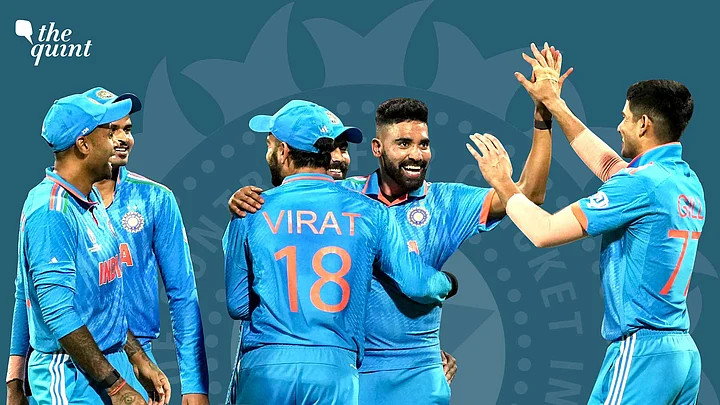Eyes were wide open. Jaws had dropped. Had they dropped any further, they would have touched the ground. Shivers ran down the spine. A lot was there to be said, but what followed was conjoint silence. The non-Indian cricketing assemblage could see, but not quite fathom, what India did to Sri Lanka – the finalists from only 12 years ago – in the 2023 ICC World Cup match on 2 November.
The scoreline read 55 all out. The hubbub sounded like – 'Can anyone stop India?'
And, in the same sequence of action, heads – of everyone looking for an answer, irrespective of their allegiance – turned to South Africa. As if to say: ‘If anyone can, they can.’ But, can they? Or, are India, well and truly, unstoppable?
The hosts, with seven consecutive wins, have been the best team in the competition so far, and by a mile or two. The only team in close proximity is South Africa, who – barring a surprisingly unsurprising defeat to the Netherlands – have won all of their other matches.
Here, we will have a look at India’s strongest suits, and analyse how the Proteas have done in those regards:
Category 1: Batting in Powerplay
Among the major reasons behind India’s scintillating run in the starts they have got with the bat, courtesy of their skipper, Rohit Sharma, leading by example.
Rohit has scored 225 runs in the first powerplay so far – 36 more than anyone else. Moreover, he accumulated those runs at a strike rate of 125.70, which is the highest among anyone who has accumulated a minimum of 100 runs inside the first ten overs.
Shubman Gill has not been as flamboyant, but his 97 runs in powerplays at a strike rate of 91.51 is as good a supporting act as India could demand.
In this aspect of powerplay utilisation, South Africa are nowhere close to India. Quinton de Kock has scored 136 runs at a strike rate of 91.89 in the first ten overs, while the only time Temba Bavuma made it to the headlines, it was because of his celebration and not batting.
Category 2: Batting in Middle Overs
For all the fantastic powerplay batting, India has scored 1787 runs in this World Cup, scoring 6.03 runs per over. Contrary to them, South Africa have scored 2365 runs at 6.48 runs per over.
So, the obvious question is – where are South Africa making up for the deficit?
The answer is equally obvious – some of it in the middle overs, and most of it at the death.
Between overs 11-40, de Kock – who has already scored four centuries – has scored 352 runs, while Aiden Markram has scored 267. They are both in the top six of this category, while the only Indian in the top 10 is Virat Kohli, with 346 runs in this phase.
Moreover, de Kock and Markram’s strike rates during the middle phase – 112.82 and 103.89 respectively, are better than that of Kohli’s (94.28).
Category 3: Batting at the Death
The main difference, however, has been the death overs batting, where South Africa have been head and shoulders ahead of everyone else, courtesy of the quartet of Heinrich Klaasen, David Miller, Marco Jansen and Aiden Markram.
All of them are among the top six run-scorers in the last ten overs, and together, they have scored 495 runs. Albeit India have been the chasing side in most of their matches, and did not even get to the death overs on two occasions, their numbers from the last three matches don’t match that of their next opposition.
Bottomline in Batting: For South African bowlers to be successful against India, wickets at the start will be of utmost importance. India, meanwhile, will need to be extremely disciplined towards the back-end of their innings with the ball.
Category 4: Bowling With the New Ball
With the new ball, India aren’t hunting in pairs, but in a triad. Of the 66 wickets India have taken in this competition, 15 came in the first ten overs, with Jasprit Bumrah, Mohammed Shami and Mohammed Siraj bagging five wickets apiece.
In South Africa’s case, Marco Jansen has been the lone hunter. With 12 wickets inside the first ten overs, Jansen is statistically the most effective new-ball bowler of the competition so far. Albeit, the power of three will hand India an advantage.
Category 5: Spin Bowling in Middle Overs
Both India and South Africa have had a successful time with the ball in the middle overs (11-40), courtesy of their spinners. For the hosts, Kuldeep Yadav and Ravindra Jadeja have scalped a total of 15 wickets – eight and seven respectively. In addition, both have maintained an economy rate of less than 5 runs per over in this phase.
South Africa have predominantly relied on a solitary spinner in Keshav Maharaj, but it is also because his performance did not scream for a complimentary spin option. Maharaj has picked up 11 wickets in the middle overs, at an economy rate of 4.90 runs per over.
Bottomline on Bowling: Albeit both teams have been successful with the new ball, and also with spin, India have a numerical advantage in terms of wicket-taking options. Their pace trio and spin twins have all been among wickets, while the Proteas have been reliant on individual brilliance.
(At The Quint, we question everything. Play an active role in shaping our journalism by becoming a member today.)
